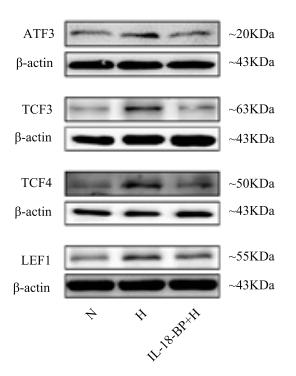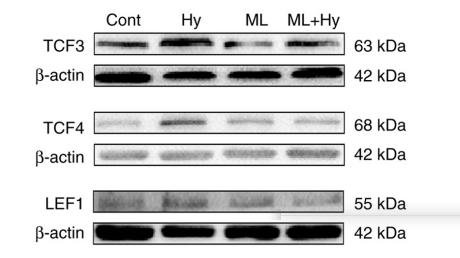TCF7L1 Antibody - #DF4573
| Product: | TCF7L1 Antibody |
| Catalog: | DF4573 |
| Description: | Rabbit polyclonal antibody to TCF7L1 |
| Application: | WB IF/ICC |
| Cited expt.: | WB |
| Reactivity: | Human, Mouse, Rat |
| Prediction: | Pig, Horse, Sheep, Rabbit, Dog, Chicken, Xenopus |
| Mol.Wt.: | 63 KD; 63kD(Calculated). |
| Uniprot: | Q9HCS4 |
| RRID: | AB_2836924 |
Related Downloads
Protocols
Product Info
*The optimal dilutions should be determined by the end user. For optimal experimental results, antibody reuse is not recommended.
*Tips:
WB: For western blot detection of denatured protein samples. IHC: For immunohistochemical detection of paraffin sections (IHC-p) or frozen sections (IHC-f) of tissue samples. IF/ICC: For immunofluorescence detection of cell samples. ELISA(peptide): For ELISA detection of antigenic peptide.
Cite Format: Affinity Biosciences Cat# DF4573, RRID:AB_2836924.
Fold/Unfold
bHLHb21; HMG box transcription factor 3; HMG box transcription factor; OTTMUSP00000023419; T cell factor 3; TCF 3; TCF-3; TCF3; Tcf7l1; TF7L1_HUMAN; Transcription factor 7 like 1 (T-cell specific, HMG-box); Transcription factor 7 like 1; Transcription factor 7-like 1;
Immunogens
A synthesized peptide derived from human TCF7L1, corresponding to a region within the internal amino acids.
Detected in hair follicles and skin keratinocytes, and at lower levels in stomach epithelium.
- Q9HCS4 TF7L1_HUMAN:
- Protein BLAST With
- NCBI/
- ExPASy/
- Uniprot
MPQLGGGGGGGGGGSGGGGGSSAGAAGGGDDLGANDELIPFQDEGGEEQEPSSDSASAQRDLDEVKSSLVNESENQSSSSDSEAERRPQPVRDTFQKPRDYFAEVRRPQDSAFFKGPPYPGYPFLMIPDLSSPYLSNGPLSPGGARTYLQMKWPLLDVPSSATVKDTRSPSPAHLSNKVPVVQHPHHMHPLTPLITYSNDHFSPGSPPTHLSPEIDPKTGIPRPPHPSELSPYYPLSPGAVGQIPHPLGWLVPQQGQPMYSLPPGGFRHPYPALAMNASMSSLVSSRFSPHMVAPAHPGLPTSGIPHPAIVSPIVKQEPAPPSLSPAVSVKSPVTVKKEEEKKPHVKKPLNAFMLYMKEMRAKVVAECTLKESAAINQILGRKWHNLSREEQAKYYELARKERQLHSQLYPTWSARDNYGKKKKRKREKQLSQTQSQQQVQEAEGALASKSKKPCVQYLPPEKPCDSPASSHGSMLDSPATPSAALASPAAPAATHSEQAQPLSLTTKPETRAQLALHSAAFLSAKAAASSSGQMGSQPPLLSRPLPLGSMPTALLASPPSFPATLHAHQALPVLQAQPLSLVTKSAH
Predictions
Score>80(red) has high confidence and is suggested to be used for WB detection. *The prediction model is mainly based on the alignment of immunogen sequences, the results are for reference only, not as the basis of quality assurance.
High(score>80) Medium(80>score>50) Low(score<50) No confidence
Research Backgrounds
Participates in the Wnt signaling pathway. Binds to DNA and acts as a repressor in the absence of CTNNB1, and as an activator in its presence. Necessary for the terminal differentiation of epidermal cells, the formation of keratohyalin granules and the development of the barrier function of the epidermis (By similarity). Down-regulates NQO1, leading to increased mitomycin c resistance.
Nucleus.
Detected in hair follicles and skin keratinocytes, and at lower levels in stomach epithelium.
The putative Groucho interaction domain between the N-terminal CTNNB1 binding domain and the HMG-box is necessary for repression of the transactivation mediated by TCF7L1 and CTNNB1.
Belongs to the TCF/LEF family.
Research Fields
· Cellular Processes > Cellular community - eukaryotes > Adherens junction. (View pathway)
· Environmental Information Processing > Signal transduction > Wnt signaling pathway. (View pathway)
· Environmental Information Processing > Signal transduction > Hippo signaling pathway. (View pathway)
· Human Diseases > Infectious diseases: Viral > Human papillomavirus infection.
· Human Diseases > Cancers: Overview > Pathways in cancer. (View pathway)
· Human Diseases > Cancers: Specific types > Colorectal cancer. (View pathway)
· Human Diseases > Cancers: Specific types > Endometrial cancer. (View pathway)
· Human Diseases > Cancers: Specific types > Prostate cancer. (View pathway)
· Human Diseases > Cancers: Specific types > Thyroid cancer. (View pathway)
· Human Diseases > Cancers: Specific types > Basal cell carcinoma. (View pathway)
· Human Diseases > Cancers: Specific types > Acute myeloid leukemia. (View pathway)
· Human Diseases > Cancers: Specific types > Breast cancer. (View pathway)
· Human Diseases > Cancers: Specific types > Hepatocellular carcinoma. (View pathway)
· Human Diseases > Cancers: Specific types > Gastric cancer. (View pathway)
· Human Diseases > Cardiovascular diseases > Arrhythmogenic right ventricular cardiomyopathy (ARVC).
· Organismal Systems > Endocrine system > Melanogenesis.
References
Application: WB Species: rat Sample: atria
Application: WB Species: Rat Sample: Atrial tissue
Application: WB Species: rat Sample: atria
Restrictive clause
Affinity Biosciences tests all products strictly. Citations are provided as a resource for additional applications that have not been validated by Affinity Biosciences. Please choose the appropriate format for each application and consult Materials and Methods sections for additional details about the use of any product in these publications.
For Research Use Only.
Not for use in diagnostic or therapeutic procedures. Not for resale. Not for distribution without written consent. Affinity Biosciences will not be held responsible for patent infringement or other violations that may occur with the use of our products. Affinity Biosciences, Affinity Biosciences Logo and all other trademarks are the property of Affinity Biosciences LTD.



